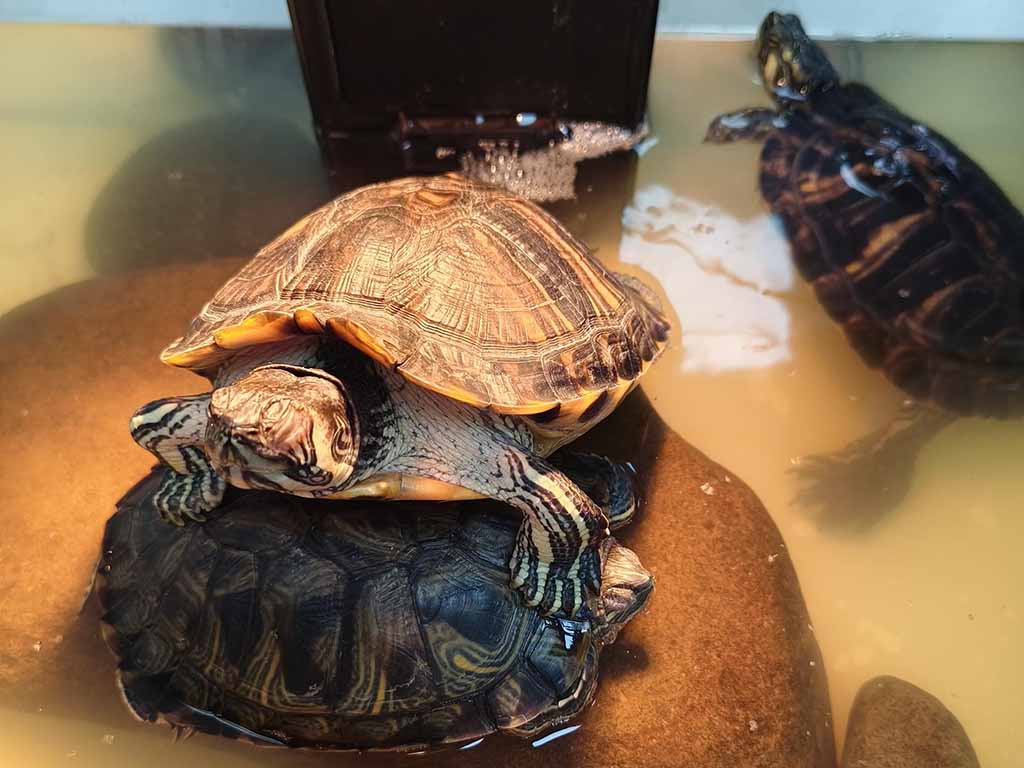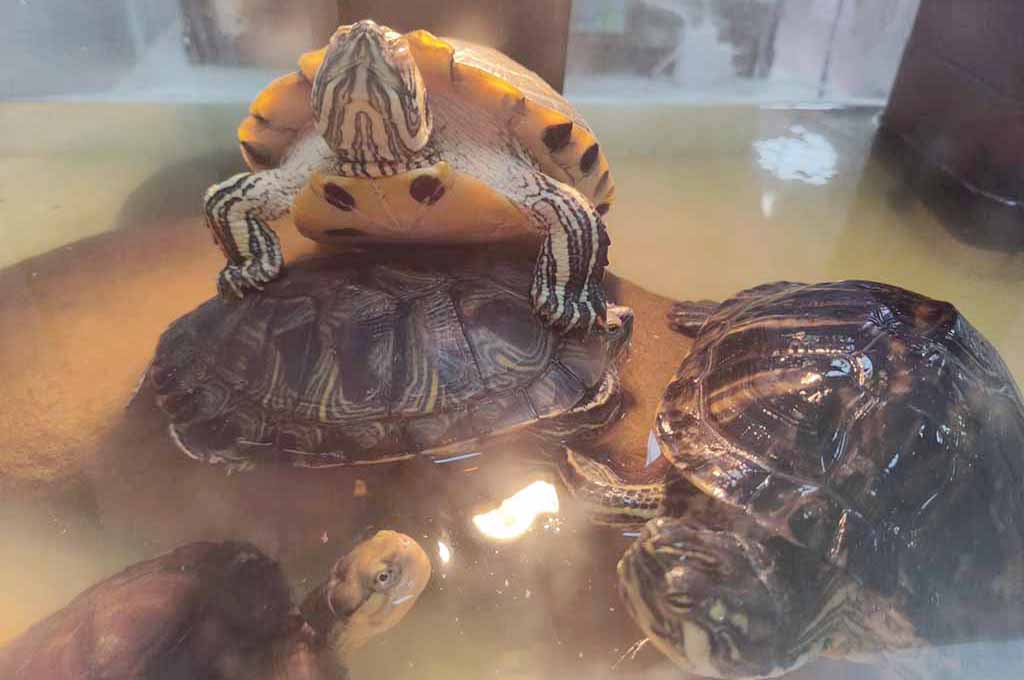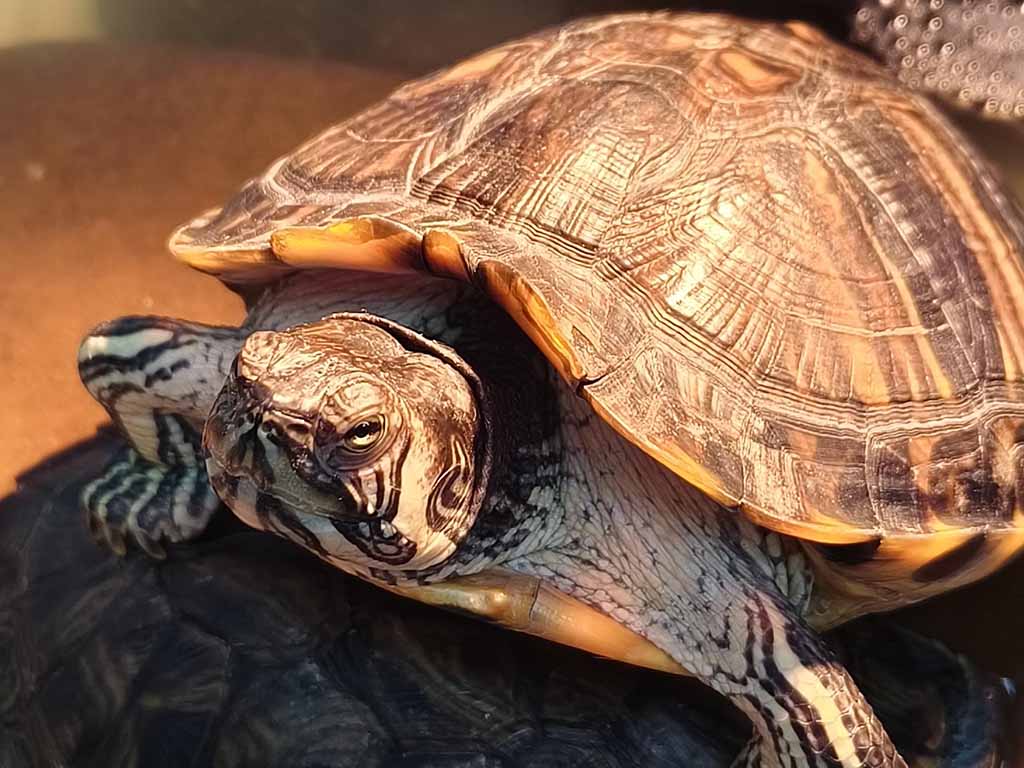Turtles are low-profile animals, and they are very old creatures that make good pets. However, many new turtle owners are always in a dilemma with concerns about their tank setup, with special emphasis on how many turtles need to be sheltered.
Content Table
Hence, this article will look into the following areas of turtles in a tank, such as turtle pet care, size of the turtle tank, suitable turtle species, and interesting facts about turtles’ teeth as well.

Turtle pet characteristics
Turtle Pet Characteristic
Here’s an overview of some common turtle pet species and their key traits:
Red-Eared Slider (Trachemys scripta elegans)
- Size: Medium (up to 12 inches)
- Temperament: Active and curious; can become friendly with regular interaction, but may be shy at first.
- Habitat: Requires both water and land areas; enjoys basking on rocks.
- Diet: Omnivorous (insects, plants, and small fish).
- Lifespan: 20–30 years.
Box Turtle (Terrapene spp.)
- Size: Small to medium (up to 7–8 inches)
- Temperament: Gentle and more terrestrial; often enjoys a calm, quiet environment.
- Habitat: Prefers land-based environments but needs access to water for hydration.
- Diet: Omnivorous (fruits, vegetables, insects).
- Lifespan: 50 years or more.
Sulcata Tortoise (Centrochelys sulcata)
- Size: Large (up to 30 inches)
- Temperament: Calm and docile, but very active and can be quite strong.
- Habitat: Needs a large outdoor enclosure with access to a warm, dry environment.
- Diet: Herbivorous (grasses, hay, and leafy vegetables).
- Lifespan: 50–70 years.
African Spurred Tortoise (Geochelone sulcata)
- Size: Very large (up to 36 inches)
- Temperament: Friendly and curious, though they can become territorial.
- Habitat: Requires a spacious outdoor enclosure with direct sunlight and dry conditions.
- Diet: Herbivorous, focusing on grasses and leafy greens.
- Lifespan: 50–150 years.
Map Turtle (Graptemys spp.)
- Size: Small to medium (up to 10–12 inches)
- Temperament: Active and social, enjoys swimming and basking.
- Habitat: Primarily aquatic; needs a large tank with access to land for basking.
- Diet: Carnivorous (small fish, insects, and aquatic invertebrates).
- Lifespan: 20–30 years.

Tank for two turtles
How Big of a Tank Do It Need for Two Turtles
The ideal tank size for two turtle pets depends on their species and adult size. Here’s a general guideline:
General Rule of Thumb:
- 10 gallons per inch of shell length for the first turtle.
- 5 gallons per inch of shell length for additional turtles.
For example:
- Two 3-inch turtles:
- 10 gallons for the first turtle + 5 gallons for the second turtle = 15 gallons
- Two 5-inch turtles:
- 10 gallons + 25 gallons = 35 gallons
However, it’s important to note that this is a minimum requirement. Larger tanks are always better, as they provide more space for swimming, basking, and natural behaviors.
How Many Turtles Are in a Tank
The number of turtles that can be housed in a tank depends on aspects like the type and size of the turtle pets in the tank plan. Here’s a general guideline for turtle stocking advice:
1. Turtle Species and Tank Size
Same Family (e.g., Red-Eared Sliders, Yellow-Bellied Sliders): These turtles can usually be housed together if they belong to the same family; you should also try to keep them of similar size as aggressive behavior may occur.
- Tank Size: If your turtle is on the medium side, between 6 and 8 inches in size, then a 75-gallon tank is best. The water requirement increases by 10–20 gallons for each turtle and decreases by 10–20 gallons for each turtle.
Different Species: In a way, painting Red-Eared Sliders alongside Painted Turtles works, however, it can at times increase the stress or lead to territorial behavior. A species that is compatible with another should be introduced when the other is already being given.
- Tank Size: For different species, the tank should be even larger so that each of the turtles has an area it wants to dwell on. There is a recommended tank size for the turtles depending on their number and species: 100 gallons tank or more for 3–4 turtles.

how many turtles in a tank
2. General Stocking Guidelines
- Small Turtles (less than 4 inches): One turtle should be placed in a 10-gallon tank of water.
- Medium Turtles (4-8 inches): 1 turtle per 20 gallons.
- Large Turtles (over 8 inches): 1 turtle per 40 gallons.
3. Tank Maintenance
It is recommended to practice cleanliness by cleaning the turtle tank frequently as it accommodates multiple turtles, and these turtles produce a lot of waste. Make sure to have dry, sandy, flat territories or rocks for basking and large enough water spaces or shelters to avoid stressing them.
Can It Keep Different Species of Turtles Together
Keeping different species of turtles together in captivity can be done, but it requires careful consideration. Here are the pros and cons to help guide your decision:
Why You Can Keep Different Species Together
- Space and Environment: Some species can be placed together if the tank is big enough, though the habitat needs should be similar (aquatic turtles, for instance, require similar water temperatures and basking).
- Behavioral Compatibility: For example, at the Kansas Wetlands Education Center, two of the turtles – the Red-eared sliders and the Yellow-Bellied Sliders are likely to breed because they share similar nature and size.
- Reduced Loneliness: Turtles are social animals, and in the wild, most of the turtles are found inhabiting the same ecological niche. It is true that in captivity, having more than one turtle would help avoid instances of loneliness.

turtle pet species
Why You Should Be Cautious About Mixing Species
- Territorial Behavior: Select turtles might become territorial, especially if the pen space or the basking area is got. This may result in aggression or stress.
- Size Differences: Large species of turtles can, in some instances, dominate the small ones, causing them stress or even, at times, physical harm. For instance, a big Red-Eared Slider can easily challenge a small turtle species such as the Painted Turtle.
- Dietary Differences: Some species require different feeding patterns, and you’ll then have to feed all the turtles separately without the others interfering.
- Disease Transmission: Mixing species from different habitats could increase the risk of diseases, as some species might be more susceptible to certain pathogens that others carry without showing symptoms.
Turtle Pet Facts: How Many Teeth Do Turtles Have
Turtles do not have teeth. Unlike little teeth like those of humans, they possess powerful and sharp beaks with which they grasp and tear food and other provisions. The structure of the beak depends on the turtle’s diet:
- Unlike most tortoises, herbivore turtles have long pointed beaks that are slightly serrated to shred vegetation.
- There are various turtles, like snapping turtles, which have bony, sharp beaks ideal for slicing meat.
In Closing
Remember, owning a turtle is a long-term commitment. Proper care, a well-maintained habitat, and a balanced diet are essential for their health and well-being. Before adding a turtle to your family, do thorough research to ensure you can provide the best possible care. If you have any questions or concerns, consult with a veterinarian or experienced turtle keeper.


Leave a comment